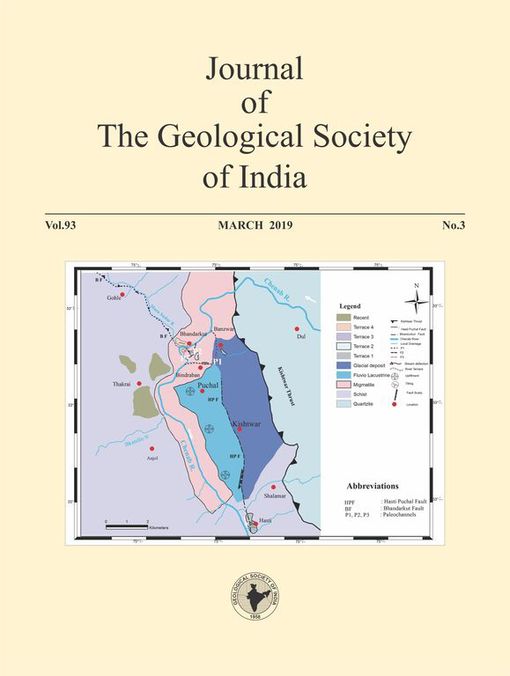The Effect of Geological Factors on the Grout Curtain Performance Analysis of Darian Dam Using the Results of Instrumentation Data in the First Impounding
DOI:
https://doi.org/10.1007/s12594-019-1185-xKeywords:
No KeywordsAbstract
Determining the conditions of underground water level is one of the key factors in geotechnical analyses. In most dam construction projects, electrical and mechanical piezometers are installed for determining groundwater conditions, water level and its seasonal fluctuations, the position of perched and confined aquifer and investigate the conditions of pore water in dam and abutments. Besides, observation wells are located to verify underground water level fluctuations in different seasons and before and after impounding in different parts of the site. In this study, seepage status, water passages, and weaknesses of gout curtain of Darian dam are evaluated. Darian earthfill dam with a height of 176 m built on the Sirvan river is located in the west of Iran. The main methods used to improve the foundation and abutments in Darian dam include grout injections, consolidation, and drainage system. After the first impounding of Darian dam, the grout curtain has not reduced the potential in a considerably of the right side of the dam. In other words, the groundwater level in the upstream and downstream of grout curtain is almost the same.
In this regard, the electrical and mechanical piezometers installed in upstream and downstream of grout curtain, iso-piezometric map, true equipotential lines, and phreatic flow line at different instrumentation levels and a downstream crosssection of grout curtain were depicted by obtaining continuous readings of observation wells. The results of instrumentation data and comparison of an iso-piezometric map of observation wells before and after impounding indicate that the grout curtain of Darian dam cuts a geologic unit with low permeability in the right side. By impounding and rise of water in the reservoir and the change in the hydro-geological boundaries, a different condition dominates both sides of this geological unit. Continuous reading of piezometers, observation wells, and drainages adequately explains that inefficiency of grout curtain on the right side is due to the water trapped behind the radiolarite unit.
Downloads
Metrics
Issue
Section
Downloads
Published
How to Cite
References
Ashjari, J. and Raeisi, E. (2006) Anticlinal structure influences on regional flow, Zagros, Iran. Jour. Cave and Karst Studies, v.68(3), pp.118– 129.
De Sortis, A. and Paoliani, P. (2007) Statistical analysis and structural identification in concrete dam monitoring. Engg. Struct., v.29, pp.110– 20.
Gerritsen, H. (2005) What happened in 1953? The Big Flood in the Netherlands in retrospect, Philosophical Transactions: Mathematical, Physical and Engineering Sciences 363(1831), pp.1271–1291.
Ghobadi, M.H., Khanlari, G.R. and Djalaly, H. (2005). Seepage problems in the right abutment of the Shahid Abbaspour dam, southern Iran. Engg. Geol., v.82, pp.119–126.
Guo Jun (2005) Recent studies and activities on dam breach in European Countries and United States. China Water Resources. No. 4, pp. 23–29 (in Chinese)
ICOLD – International Commission on Large Dams. Bulletin on risk assessment in dam safety management; 2003.
ICOLD Bulletin 111, Dam-break flood analysis, 1998.
Mahab Ghods consulting engineer (2009) Final report of engineering geology of Darian dam, 153p.
Mahab Ghods consulting engineer. (2011) Final grout curtain and seepage analysis of Darian dam, 56p.
Malkawi, A.I.H. and Al-sheriadeh, M. (2000) Evaluation and rehabilitation of dam seepage problems, A Case Study: Kafrein Dam. Engg. Geol., v.56, pp.335–345.
McCully, P. (1996) Silenced rivers: The ecology and politics of large dams, Zed Books, London & New Jersey.
Merritt, H. (1996). Geotechnical aspects of the design and construction of dams and pressure tunnels in soluble rocks. In: Internat. Jour. Rock Mechanics and Mining Sciences and Geomechanics Abstracts, v.2(33), pp.86A–86A.
Milanovic, P.T. (1981) Karst hydrogeology. In: Karst hydrogeology. Water Resources Publications, 434p.
Mohammadi, Z., Raeisi, E. and Bakalowicz, M. (2006) Method of leakage study at the karst dam site, A case study: Khersan 3 Dam, Iran. Environ. Geol., v.52(6), pp.1053–1065.
Qing, D. (1997) The River Dragon has come! : Three Gorges dam and the fate of China's Yangtze River and its people, ME Sharpe.
Turkmen, S., í–zgüler, E., Taga, H. and Karaogullarindan, T. (2002) Seepage problems in the karstic limestone foundation of the Kalecikdam (south Turkey). Engg. Geol., v.63(3), pp.247–57.
Vafaeian, M. (1998) Rock engineering properties, Arkan Esfahan Publication (in Persian).
Wang, L.H. and Hu, S.Y. (2007) Study on dam failure-related problems. Advances in Science and Technology of Water Resources, v.27(1), pp.80– 85 (in Chinese).
Xie Jiabi, Sun Dongya. Statistics of dam failures in China and analysis on failure causations (2009) Water Resources and Hydropower Engineering, v.40(12): pp.124-128.
ZagonjollI, M. (2007) Dam break modelling, risk assessment and uncertainty analysis for flood mitigation, PhD thesis, Delft University of Technology.

 Seyed Mahmoud Fatemi Aghda
Seyed Mahmoud Fatemi Aghda






